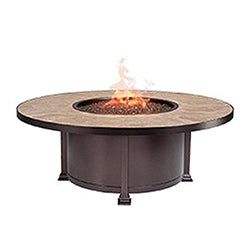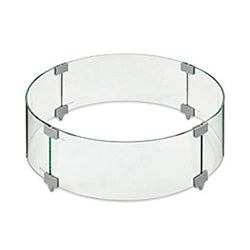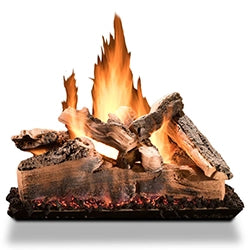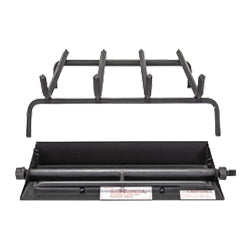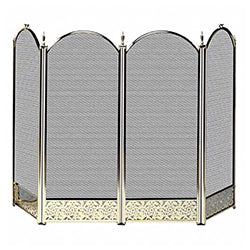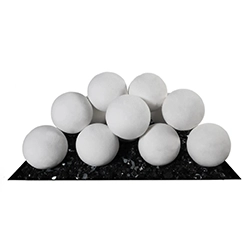Your brand new fire pit is freshly installed, and you’re excited to turn on the gas and enjoy the flames. Before you do that, however, we recommend running through this safety checklist first. Why? Gas can be dangerous if not utilized properly, and to ensure the safety of you and your loved ones, it needs to be taken seriously. By completing this checklist, you’ll have caught any small issues that could have caused you problems in the future.
Especially for Propane
When using a portable propane tank, there are some additional steps you need to make.
Propane Tank
Make sure that your tank is positioned upright, not laying on its side. Standard 20 lb tanks have a valve that will freeze when laid to the side, causing problems with the flow of gas to your fire pit. If your fire pit can’t house a propane tank upright, you can keep the tank separate from the fire pit and cover it in a matching tank cover, or you can purchase a specialty 11 lb propane tank, which is designed to fit smaller spaces.
While you’re checking on the orientation of your tank, also double check the fitting between your tank and the other components. Make sure the fitting is sealed correctly—it should be tight. If it’s loose, tighten it, and if it just doesn’t tighten, you probably have a stripped fitting which will need to be replaced. Be careful not to over tighten. If the parts aren’t perfectly fitting you run the risk of a cross thread, which can cause gas leaks.
Regulator
 A propane regulator helps to provide a constant and steady flow of gas pressure.
A propane regulator helps to provide a constant and steady flow of gas pressure.
If you’re using propane gas, you need a regulator. A regulator, which works directly in correlation with the gas valve, helps control and provide a constant and uniform gas pressure. If you don't have one installed, do not turn on your fire pit until you have one installed. Not having a regulator will result in low pressure, which will simply prevent the gas from coming out, or it will result in high pressure, which will likely be in excess of the fire pit’s rating, opening up the possibility of an explosion occurring. No one wants to deal with an explosion—get a regulator.
Make sure the regulator you’re using is the correct one for your fire pit. Standard 20 lb propane tanks cannot produce more than 90,000 BTUs, so you’ll want to make sure your regulator is sized properly in line with the specifications required for your appliance. If you’re unsure what is required, we highly recommend contacting a professional and certified gas specialist.
Also keep in mind that because regulators have internal doors that allow gas to pass through, it is important to check for gas leaks. Even if your key valve is turned off, gas can continue flowing through if the internal door becomes stuck. In the event of a gas leak occurring with your propane regulator, you’ll need to replace it with a new one.
Propane Air Mixer
 An air mixer is required for gas fire pits running on propane as this essential component helps draw in fresh air to fuse and dilute with propane. This ensures your fire pit burns efficiently.
An air mixer is required for gas fire pits running on propane as this essential component helps draw in fresh air to fuse and dilute with propane. This ensures your fire pit burns efficiently.
Inspect that the air mixer, which is designed to draw fresh air in to fuse and dilute with propane, is installed correctly underneath the burner and not further downstream on the gas line as this can cause back pressure. In addition, because this fitting is designed to shoot gas into the mixing chamber, installing it backwards can cause a gas leak.
Connections
 Inspecting each of your connections and checking they are correctly installed and securely fastened in place ensures proper performance and better flames.
Inspecting each of your connections and checking they are correctly installed and securely fastened in place ensures proper performance and better flames.
Inspect all connections, including the gas hose and fittings, to ensure they are all tightened securely in place and not cross threaded. Standard pipe thread fittings should be sealed with gas approved pipe joint compound or yellow Teflon tape, which can be found at your local home improvement store, to prevent gas leaks. Keep in mind, however, that pipe joint compound and yellow Teflon tape should never be applied to flared compression fittings. Because compression fittings are already designed to compress and seal as they are tightened, adding a thread sealant can prevent them from fully sealing—which in turn, can result in a potential gas leak.
Tighten the fittings securely in place with the appropriate tools rather than manually by hand to ensure a proper seal. Flex lines and gas hoses should be inspected for cracks, slits, and breaks. If such parts appear to have damage, they will need to be replaced with new ones.
Ventilation
 Having adequate ventilation for your gas fire pit ensures successful operation and proper performance. Air flow is needed to minimize overheating, regulate temperature, and promote optimal cross ventilation.
Having adequate ventilation for your gas fire pit ensures successful operation and proper performance. Air flow is needed to minimize overheating, regulate temperature, and promote optimal cross ventilation.
Fire pits, especially those that run on propane, require proper ventilation. Because propane is heavier than air, it will sink and pool to the floor. As such, it is common for gas leaks to go undetected until an explosion occurs—therefore, they need to be ventilated with two to four vents at the bottom. Each vent should be the size of a brick or larger.
To ensure proper performance, double check the vents are not blocked by any loose debris or clutter as this can prevent propane from ventilating out. Heat that is unable to escape can build up excessively inside the enclosure and can result in the potential danger of an explosion.
As always, it is very important to follow the instructions provided in your fire pit's owners manual. Check to see if your fire pit package includes a mounting bracket or leveling feet to be installed at the bottom of the whole unit as this component is designed to support and lift your fire pit up and off the ground for air flow and ventilation. Inspect that this component is installed correctly and not upside down.
Gas Leak Test
 Before turning on your gas fire pit, it's always best practice to perform a gas leak test wherever there are connections. Ensuring there are no gas leaks will give you and your loved ones peace of mind and help you feel safe and secure. Never use an open flame to test for gas leaks.
Before turning on your gas fire pit, it's always best practice to perform a gas leak test wherever there are connections. Ensuring there are no gas leaks will give you and your loved ones peace of mind and help you feel safe and secure. Never use an open flame to test for gas leaks.
Once you've confirmed all connections are correctly installed and securely fastened, it is always important to run a gas leak test prior to igniting your fire pit for further peace of mind. If you don't have gas leak detector spray on hand, you can use a simple soapy water solution as an alternative. This just requires mixing dish soap with water in an empty spray bottle.
If your fire pit runs on propane, turn the propane tank on but keep the fire pit valve turned to the off position. You'll want to liberally spray the gas leak detector spray or soapy water solution wherever there is a connection, such as the propane tank valve, regulator, valve connections, etc. This may require multiple sprays. If bubbles form and become visible where you've sprayed the solution, that means a gas leak is present. Never use an open flame when testing for gas leaks.
After you've pinpointed any problem area, you'll want to correct any connections and or fittings that are improperly installed. If using a propane tank, is the cylinder positioned upright and do you have a regulator and air mixer correctly installed? Are there any loose connections or fittings? Are all standard pipe thread fittings—excluding flared compression fittings—properly sealed with gas approved thread sealer? Is there any damage to any of the components? Do you have proper ventilation? Repeat the gas leak test with your gas leak detector spray or soapy water solution in the same area to ensure there are no bubbles. Then repeat this same procedure for all other connections. Once you're certain there are no leaks, shut the gas off and wipe everything down.
While it can be exciting to turn your gas fire pit on right away, it's important to remember that gas is hazardous, so taking the additional steps to ensure the safety and security of you and your loved ones is important. If you're not confident in performing the above checklist procedures, hire a local certified and professional gas installer to verify your fire pit is installed correctly. Still have questions? For any additional questions on this subject—or for expert help on any project—feel free to contact our friendly and knowledgeable staff by filling out this simple form.
Before igniting your gas fire pit, it's best practice to run through a safety checklist first to ensure the safety of you and your loved ones (Pictured: Tavola 1 Gas Fire Pit by Prism Hardscapes)







